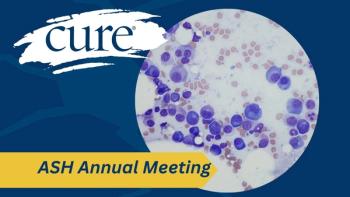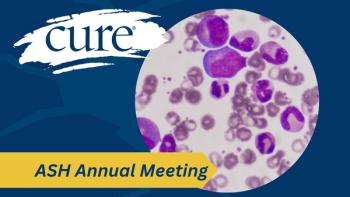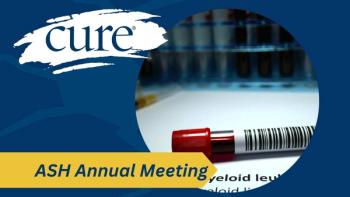
- Hematology Special Issue (March)
- Volume 1
- Issue 1
A New Chapter Begins With CML
Hope is growing for patients who are living with CML.
At first, Kelly Starling just felt numb. When the 46-year-old heard on August 23, 2012, that she had chronic myeloid leukemia (CML), her biggest concern was that her three adolescent children would have to watch her go through the trials of chemotherapy, lose her hair and suffer the awful side effects. But then, like so many other patients diagnosed with CML, she was told, “If you’re going to have leukemia, this is the very best kind to have.”
This isn’t always the most comforting follow-up to a cancer diagnosis, but it refers to the fact that CML is a very treatable leukemia that rarely causes death — that wasn’t always the case.
Chronic myeloid leukemia develops when certain bone marrow cells acquire a mutation that causes white blood cells to grow out of control. Until 2001, scientists had no way to stop the cells with mutations from taking over. Interferon could extend a patient’s life up to five or 10 years, but the only cure was and remains a stem cell transplant. This involves high doses of chemotherapy to kill the leukemia cells, but this also damages normal bone marrow cells. A stem cell transplant can then take place. The most common is an allogeneic transplant, where the stem cells come from a donor.
However, when the new drug Gleevec (imatinib) was approved in May 2001 by the Food and Drug Administration (FDA), it exceeded everyone’s expectations and permanently changed the landscape of CML treatment. Gleevec converted an almost certain death sentence into a normal life span, usually with a reasonably good quality of life. But there was a catch: Those living with CML would need to take an increasingly expensive medication daily for the rest of their lives. Now, new evidence suggests that edict is changing.
Gleevec is a tyrosine kinase inhibitor (TKI), a drug that targets the protein in CML that directs white cells to multiply uncontrollably, and thereby, prevent other bone marrow cells from properly developing. This protein, which produces the enzyme tyrosine kinase, is itself produced by the fusion of two genes, the ABL gene on chromosome 9 and the BCR gene on chromosome 22. Their fusion, which is due to a chromosomal breakage and reconnection known as a translocation, creates the “Philadelphia chromosome” that characterizes CML.
Five FDA-approved TKIs inhibit this errant protein’s signal: Gleevec, Sprycel (dasatinib), Tasigna (nilotinib), Bosulif (bosutinib) and Iclusig (ponatinib). Gleevec was the first TKI, but second-generation drugs Sprycel and Tasigna have joined it as first-line treatments and may induce a stronger response than Gleevec. Bosulif and Iclusig are currently only used in patients who develop resistance or intolerance to the three first-line TKIs or develop a mutation, such as the T315I mutation.
Starling had become one of the more than 8,000 people newly diagnosed with CML in the United States each year. Soon she would become one of more than 70,000 people in the U.S. who live with it daily. And just over three years later, she would be among a few thousand or so to experience treatment-free remission.
“As a mom, I can go through a lot, as long as my kids don’t have to witness it, so it was a relief that my family wasn’t going to have to watch me get chemo and all those side effects,” says Starling. But she wasn’t anticipating how the side effects of Sprycel would knock her almost as flat as chemotherapy might have. The TKI that patients start taking first depends on their age, lifestyle, other health conditions, insurance coverage and, sometimes, personal preference. If they cannot tolerate the side effects of that TKI after a reasonable trial, they may switch to another. Starling’s doctor had given her the choice of Sprycel or Tasigna; she chose Sprycel to avoid dietary changes required for Tasigna.
“The first four months, I had every side effect there was and ended up in the hospital for eight days while they tried to figure out what was going on,” she says. Starling had a fever for nearly a month, developed a rash, always felt exhausted, and ended up with almost a liter of fluid in her left lung, a condition called pleural effusion, which is a known side effect of Sprycel. Some of these symptoms likely came from the Lyme disease she didn’t know she had until her immune system became weakened enough for symptoms to appear.
After the standard course of antibiotics, the Lyme disease cleared up, but she still felt exhausted and had developed rheumatoid arthritis for what her doctor believes is as a result of the Sprycel. “I tried to pretend like this was not going to be a big deal because they told me ‘life’s not going to change, and you’ll be fine, just take the pill,’ but I was tired all the time,” Starling says.
Her experience was not unique. TKIs are remarkably effective in halting CML — Gleevec caused 10-year survival rates to jump from less than 20 percent to more than 80 percent — but anywhere from a third to more than half of those taking a TKI experiences side effects ranging from mildly uncomfortable to utterly unbearable. In fact, due to side effects and possibly other reasons, compliance with treatment, even though life-saving, is far from ideal.
Common side effects with Gleevec include nausea, fluid retention, swelling around the eyes, fatigue, diarrhea and muscle cramps. In addition to pleural effusion, rash and fatigue, Sprycel can cause nausea, diarrhea and headache. Less commonly, it can cause anemia, a low white blood cell count (neutropenia), a low platelet count (thrombocytopenia) and high blood pressure in the lungs (pulmonary hypertension). Tasigna can come with low blood counts, pleural effusion, rash, headache, nausea, diarrhea and itching. Rare, but more serious concerns with Tasigna include high blood sugar (hyperglycemia), pulmonary hypertension or swelling of the liver or pancreas, and both Sprycel and Tasigna carry cardiac risks.
When Starling’s doctor asked if she wanted to switch to another TKI, she declined. The side effects were awful, but Starling had responded to Sprycel faster than anyone else her doctor had ever seen. The primary goal of CML treatment is a thousand-fold reduction in leukemia cells, called major molecular response (MMR), ideally within 12-24 months. MMR follows a first-level hematologic response (a tenfold reduction, ideally achieved within three months) and a cytogenetic response (absence of Philadelphia chromosome in marrow cells). Starling had reached MMR — just 0.4 percent of her cells had the Philadelphia chromosome — in less than four months. Yet she was only taking 100 mg of Sprycel, the dose most people start with before titrating up to 140 mg.
“It was magical. It worked so fast that I said I don’t want to leave this one,” says Starling. But she wanted a lower dose. “I talked to my oncologist and said if it worked that well, I’d like to try 70 mg,” she adds. She figured the awful side effects occurred partly because the dose was high for her, even if it was low for most people. Dropping to 70 mg goes against the recommendations for Sprycel, but her oncologist agreed, and she continued to improve. Within a year, she reached complete molecular response (CMR), with less than 0.003 percent of her blood cells containing the Philadelphia chromosome. She dropped down to 50 mg.
“My husband and I talked about it and decided if I could maintain CMR on any dosage, then we would ask for the next lower one,” Starling says. She knew what she was doing was completely contrary to Sprycel protocol, but three years and three months after starting therapy, Starling became a “CML outlier,” as one of her oncologists called her.
She enrolled in the LAST trial — Life After Stopping Tyrosine Kinase Inhibitors study, which is ongoing — and joined a small, intermediate number of other people in the world who had been able to safely stop taking TKIs without the CML roaring back.
STOPPING TKIS TO ACHIEVE TREATMENT-FREE REMISSION
In the French STIM trial, the first to explore ending TKI treatment, the 100 participants had maintained a deep response for at least two years before discontinuing Gleevec; 39 percent maintained a deep molecular response 24 months after stopping and none who relapsed saw their disease progress. In another small, early study, TWISTER, 47 percent of patients maintained treatment-free remission at 24 months. In trials that followed, stopping Sprycel and Tasigna showed slightly higher success rates, and larger trials in Europe such as EURO-SKI, have now established that somewhere between 50 and 60 percent of ideal patients safely and successfully stop TKI therapy.
“I think it’s clear that some patients can safely stop therapy,” says Jorge Cortes, M.D., chief of the CML and AML sections and deputy chair of the Department of Leukemia at MD Anderson Cancer Center in Houston, Texas. “But I think there is still concern because, number one, I don’t think everybody understands in what patients it is safe to stop.”
The other major concern is whether potential candidates receive frequent and sensitive enough monitoring to be sure their values are accurate. “Not everyone has a polymerase chain reaction (PCR) that’s that sensitive or even know the sensitivity of the assay they’re using,” Cortes adds.
Until very recently, a debate among researchers questioned whether patients should have to be in clinical trials to attempt stopping TKI treatment or whether any appropriate candidates could do so with their oncologist’s supervision. “Does everyone know who can stop, and can they be monitored correctly?” asks Ehab Atallah, M.D., an associate professor of hematology and oncology at Medical College of Wisconsin and Froedtert Hospital in Milwaukee and a lead investigator of the LAST trial. “If both of those are satisfied, there should be no problem in discontinuation.”
The ideal patient has taken a first-line TKI (not Bosulif or Iclusig) for at least three years and has sustained an MMR (identified as a percentage or a log reduction) for at least two years, assessed every six months with adequately sensitive PCR testing. Atallah requires a PCR value of less than 4 logs, and Cortes requires patients to have a 5-log reduction in their cancer cells. Most studies have required at least a 4.5-log reduction.
“The duration of the deep response is very important,” Cortes says. “In our experience, that seems to be more important than the duration of treatment itself, and it’s very difficult to differentiate the duration of deep response from the duration of treatment.” In the EURO-SKI study, for example, each additional year of treatment increased patients’ odds of maintaining MMR by 16 percent six months later.
Ideal candidates for stopping therapy should also have always remained in the disease’s chronic phase — never advancing to accelerated or blast phase. Most CML patients receive their diagnosis in chronic phase, when less than 10 percent of their blood or bone marrow samples contain immature cells called blasts. Patients with 10 to 20 percent blasts who are not improving are in accelerated phase, and more than 20 percent blasts in the patients’ marrow or blood cells indicates blast phase.
Proper monitoring after stopping TKIs ensures oncologists don’t miss any early signs of a relapse, says Aref Al-Kali, M.D., assistant professor of medicine and the program director for leukemia fellowship at Mayo Clinic in Rochester, Minnesota.
“It is critical that it is done in the right setting, in the right patients, with the right understanding, with the right monitoring,” Al-Kali says. “You don’t want to create a problem for patients who are, by definition, doing well.”
After stopping TKIs, people should undergo testing monthly for the first six months, then every two months for the next 18 months and every three months thereafter for life, though some slight variation in this schedule exists.
Patients who have switched from one first-line TKI to another because of side effects to achieve an even deeper response have shown similar chances of successfully stopping treatment. Patients who develop resistance to one of the TKIs, however — those who have a relapse or don’t initially respond optimally — have a lower likelihood of successfully stopping treatment, estimated at 30 percent success based on one small, unpublished trial, Atallah says. But no other factors — age, sex, other health conditions — appear to affect whether patients do or don’t relapse.
“We have no idea why some people relapse and some don’t,” he says. “That’s one of the big areas of research.”
SHOULD YOU STOP TKIS? THE ADVANTAGES AND DISADVANTAGES
The three main physical risks of stopping TKI treatment, according to Al-Kali, are withdrawal symptoms, relapse of the disease and, very rarely, progression of the disease. Most people who stop TKIs and relapse, then return to a deep response when they start the medication again, but 1 to 2 percent of people in the trials have seen their disease progress.
“It’s really about making the patient know the pros and cons of being on the drug versus being off the drug,” he says. “Make that decision in a dialogue that’s patient driven.”
Relapse, for example, can be both psychologically and physically painful. The side effects a patient experienced with the TKI initially may return, which can lead to anxiety and depression for a short period of time.
In addition, about 30 percent of patients, who stop TKIs, experience joint, bone and muscle pain during withdrawal. When Starling took her last Sprycel on November 18, 2015, it wasn’t smooth sailing.
“The first day without Sprycel was one of the most excruciating days I’ve ever had,” Starling says. “My long bones and my hips — I hurt all over. I remember crying and thinking, ‘Man, 20 mg of Sprycel and I don’t have to go through this, but I wanted to do my part to help write the next book on CML.’ ” She persisted, and the intense pain eventually passed. But for some, the bone and joint pain is so painful that they return to TKI treatment.
Of course, the side effects of taking TKIs is one of the major reasons many people want to stop. Further, patients who have diabetes or have experienced a stroke or heart attack may want to stop treatment to reduce any additional cardiac risks or to more easily manage their diabetes, Cortes notes.
“Lastly, is long-term toxicity, which we don’t know about at all,” Atallah adds. “Up until now, there has been no signal that there is long-term toxicity, but we don’t have data for 30 and 40 years out.”
Another reason a patient may want to stop TKIs is to conceive. Cortes says he sees younger women who want to become pregnant. Most research on TKIs during pregnancy comes from animal studies, which show significant negative effects on the fetus, such as severe neurologic problems or deformities.
Perhaps the biggest reason to stop treatment is financial: TKIs carry a hefty price tag. Gleevec cost $26,000 to $30,000 a year in 2001, but has since tripled. As of 2013, TKIs cost patients $92,000 to $138,000 annually, with no sign of dropping even though pharmaceutical companies had long since recouped development costs for drugs no one expected to become lifelong therapies.
However, Al-Kali points out, that may change this year: In February 2016, the first generic imatinib (Gleevec) became available. In 2017, more generic imatinib may become available, so the price of Gleevec may drop to compete, possibly putting market pressure on the other first-line TKIs to drop in price as well.
Despite the advantages, people who choose to stop TKIs should not necessarily expect massive changes in their lives. “Interestingly enough, a few studies looked at the quality of life of patients, and, on average, it doesn’t change much,” Cortes says. “That is important to manage expectations.”
For Starling, stopping seemed like the next logical step. But now, in addition to the withdrawal pains, she’s contending with guilt she didn’t anticipate since many friends she made in the CML community are still dealing with what she’s largely left behind.
“It’s been a blessing, even feeling a little lost and not knowing where I stand in the CML community — that’s OK,” says Starling. “It’s even more fulfilling knowing that this data is actually going to benefit someone.” Her participation in the LAST trial may help guide decisions for current and future CML patients.
“Taking a disease that 20 years ago was a death sentence and it’s now turned into something that I haven’t had to take anything for in 14 months, that’s amazing.”
Articles in this issue
almost 9 years ago
Debunking the Myths of Stem Cell Donationalmost 9 years ago
Make Multiple Myeloma Clinical Trials More Diversealmost 9 years ago
Zeroing In on CAR T-Cell Therapy




